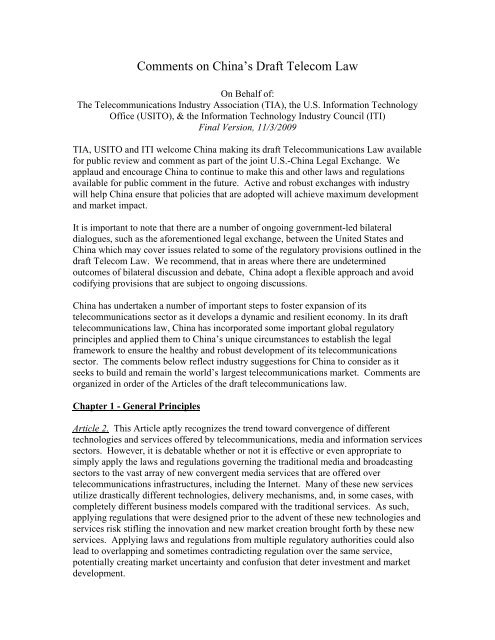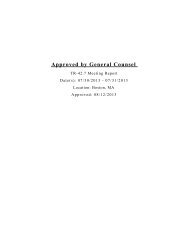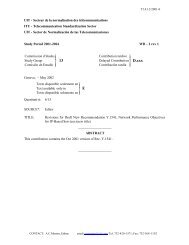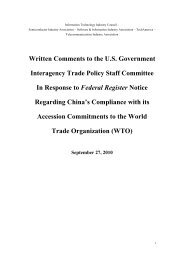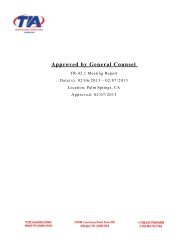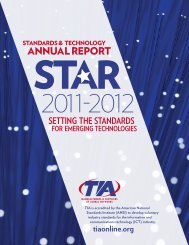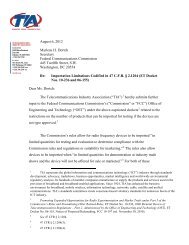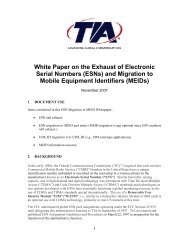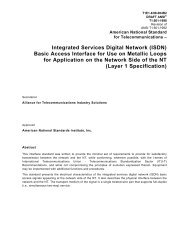Comments on China's Draft Telecom Law - Telecommunications ...
Comments on China's Draft Telecom Law - Telecommunications ...
Comments on China's Draft Telecom Law - Telecommunications ...
Create successful ePaper yourself
Turn your PDF publications into a flip-book with our unique Google optimized e-Paper software.
<str<strong>on</strong>g>Comments</str<strong>on</strong>g> <strong>on</strong> China’s <strong>Draft</strong> <strong>Telecom</strong> <strong>Law</strong>On Behalf of:The <strong>Telecom</strong>municati<strong>on</strong>s Industry Associati<strong>on</strong> (TIA), the U.S. Informati<strong>on</strong> TechnologyOffice (USITO), & the Informati<strong>on</strong> Technology Industry Council (ITI)Final Versi<strong>on</strong>, 11/3/2009TIA, USITO and ITI welcome China making its draft <strong>Telecom</strong>municati<strong>on</strong>s <strong>Law</strong> availablefor public review and comment as part of the joint U.S.-China Legal Exchange. Weapplaud and encourage China to c<strong>on</strong>tinue to make this and other laws and regulati<strong>on</strong>savailable for public comment in the future. Active and robust exchanges with industrywill help China ensure that policies that are adopted will achieve maximum developmentand market impact.It is important to note that there are a number of <strong>on</strong>going government-led bilateraldialogues, such as the aforementi<strong>on</strong>ed legal exchange, between the United States andChina which may cover issues related to some of the regulatory provisi<strong>on</strong>s outlined in thedraft <strong>Telecom</strong> <strong>Law</strong>. We recommend, that in areas where there are undeterminedoutcomes of bilateral discussi<strong>on</strong> and debate, China adopt a flexible approach and avoidcodifying provisi<strong>on</strong>s that are subject to <strong>on</strong>going discussi<strong>on</strong>s.China has undertaken a number of important steps to foster expansi<strong>on</strong> of itstelecommunicati<strong>on</strong>s sector as it develops a dynamic and resilient ec<strong>on</strong>omy. In its drafttelecommunicati<strong>on</strong>s law, China has incorporated some important global regulatoryprinciples and applied them to China’s unique circumstances to establish the legalframework to ensure the healthy and robust development of its telecommunicati<strong>on</strong>ssector. The comments below reflect industry suggesti<strong>on</strong>s for China to c<strong>on</strong>sider as itseeks to build and remain the world’s largest telecommunicati<strong>on</strong>s market. <str<strong>on</strong>g>Comments</str<strong>on</strong>g> areorganized in order of the Articles of the draft telecommunicati<strong>on</strong>s law.Chapter 1 - General PrinciplesArticle 2. This Article aptly recognizes the trend toward c<strong>on</strong>vergence of differenttechnologies and services offered by telecommunicati<strong>on</strong>s, media and informati<strong>on</strong> servicessectors. However, it is debatable whether or not it is effective or even appropriate tosimply apply the laws and regulati<strong>on</strong>s governing the traditi<strong>on</strong>al media and broadcastingsectors to the vast array of new c<strong>on</strong>vergent media services that are offered overtelecommunicati<strong>on</strong>s infrastructures, including the Internet. Many of these new servicesutilize drastically different technologies, delivery mechanisms, and, in some cases, withcompletely different business models compared with the traditi<strong>on</strong>al services. As such,applying regulati<strong>on</strong>s that were designed prior to the advent of these new technologies andservices risk stifling the innovati<strong>on</strong> and new market creati<strong>on</strong> brought forth by these newservices. Applying laws and regulati<strong>on</strong>s from multiple regulatory authorities could alsolead to overlapping and sometimes c<strong>on</strong>tradicting regulati<strong>on</strong> over the same service,potentially creating market uncertainty and c<strong>on</strong>fusi<strong>on</strong> that deter investment and marketdevelopment.
We recommend that China c<strong>on</strong>sider establishing a c<strong>on</strong>vergent, independent, regulator asthe central authority governing the c<strong>on</strong>verging telecom, Internet media, and broadcastindustries. We also recommend a multi-tiered, principle-based (as opposed to rulesbased)regulatory framework that employs both traditi<strong>on</strong>al command-and-c<strong>on</strong>trolapproaches and light-touch approaches such as industry self-regulati<strong>on</strong> and/or coregulati<strong>on</strong>,depending <strong>on</strong> the nature and maturity of the service under c<strong>on</strong>siderati<strong>on</strong>.Article3. China should be commended for realizing the important benefits oftelecommunicati<strong>on</strong>s networks to developing the Chinese ec<strong>on</strong>omy. Unfortunately,regulatory processes in China today exist without clearly defined regulatoryresp<strong>on</strong>sibilities. While MIIT has been, in practice, the lead agency with respect toregulating the <strong>Telecom</strong>municati<strong>on</strong>s sector, other government organs (SARFT, SEMB,CNCA, etc) also play a role. It would be helpful to industry if the <strong>Telecom</strong>municati<strong>on</strong>slaw could clearly define what c<strong>on</strong>stitutes the “competent telecommunicati<strong>on</strong>s authorities”and, in additi<strong>on</strong>, their areas of policy resp<strong>on</strong>sibility with respect to thetelecommunicati<strong>on</strong>s sector. With this in mind, we remind China of its WTO Basic<strong>Telecom</strong>municati<strong>on</strong>s Agreement Reference Paper commitment to establish anindependent regulator. MIIT, with its multiple policy and industry functi<strong>on</strong>s has a clearc<strong>on</strong>flict of interest when it comes to regulating the telecommunicati<strong>on</strong>s industry in an<strong>on</strong>discriminatory and transparent manner.We applaud the State’s support and promoti<strong>on</strong> of network c<strong>on</strong>vergence and theencouragement of cross-entry am<strong>on</strong>g telecom and broadcast service providers. Webelieve that these policy advancements will nurture healthy and increased marketcompetiti<strong>on</strong> and benefit both the c<strong>on</strong>sumers and the nati<strong>on</strong>’s ec<strong>on</strong>omy as a whole. Wenotice, however, the subtle difference in that broadcast organizati<strong>on</strong>s are encouraged toengage in the telecom business (with no limitati<strong>on</strong>s) while telecom operators areencouraged to engage in radio and TV transmissi<strong>on</strong> businesses, which seems to limit thetelecom operators to <strong>on</strong>ly the transmissi<strong>on</strong> aspect of radio and TV businesses. As radioand TV services migrate <strong>on</strong>to digital and interactive technology platforms, the associatedbusiness models also undergo tremendous change and often require end-to-end businessintegrati<strong>on</strong> across c<strong>on</strong>tent packaging, c<strong>on</strong>tent delivery (transmissi<strong>on</strong>), and c<strong>on</strong>tentpresentati<strong>on</strong> (user interfaces/devices) in order to enable service innovati<strong>on</strong> and maintainservice competitiveness. As such, we recommend that the qualifier term “transmissi<strong>on</strong>”in the last sentence of Article 3 be removed to signify the encouragement of truly equalentry am<strong>on</strong>g telecom and broadcast service operators.Article 4. We applaud China for including an Article in the law that protects citizens’freedom and privacy. In the same spirit, we urge China to c<strong>on</strong>sider an additi<strong>on</strong> to theArticle giving c<strong>on</strong>sumers the freedom to choose a telecommunicati<strong>on</strong>s service provider,thus reinforcing steps taken to create competiti<strong>on</strong> in the Chinese telecommunicati<strong>on</strong>smarket.Article 5. We recognize China’s c<strong>on</strong>cern with respect to misuse of thetelecommunicati<strong>on</strong>s networks. However, it is important from a legal perspective for
Chapter 3 - Interc<strong>on</strong>necti<strong>on</strong> of and Intercommunicati<strong>on</strong> Between<strong>Telecom</strong>municati<strong>on</strong>s NetworksArticle 19. While we understand Chinese desires to understand the overall networkinfrastructure, it would be helpful if the law could be more explicit in not applying thisrequirement to new entrants, who will not be in a market dominant positi<strong>on</strong> and wouldfind such reporting requirements overly burdensome.Article 20. The obligati<strong>on</strong>s c<strong>on</strong>tained in this Article should apply <strong>on</strong>ly to operators,which are major suppliers as defined in the WTO Reference Paper. New entrants willneed access to the networks of the major suppliers <strong>on</strong> reas<strong>on</strong>able terms and c<strong>on</strong>diti<strong>on</strong>sand will not have much leverage to negotiate. By requiring that major suppliers makecomprehensive interc<strong>on</strong>necti<strong>on</strong> offers to new entrants, the <strong>Telecom</strong> <strong>Law</strong> would send astr<strong>on</strong>g signal that China’s goal is to foster healthy competiti<strong>on</strong> in the telecom sector.Articles 22 and 24. We recommend further clarificati<strong>on</strong> <strong>on</strong> how the government willc<strong>on</strong>duct arbitrati<strong>on</strong> proceedings for settlement of interc<strong>on</strong>necti<strong>on</strong> disputes and whatgovernment body will oversee this process.Chapter 4 - <strong>Telecom</strong>municati<strong>on</strong>s ResourcesArticle 28. While it is normal to charge fees for use of wireless frequencies, we proposethat China also clarify which government body will be given resp<strong>on</strong>sibility for setting thefees, explain how the fees will be established, and provide informati<strong>on</strong> <strong>on</strong> what legalredress (fines, administrative measures, etc) available should an entity interfere with thespectrum use of a licensed holder of same spectrum.Article 29. China recognizes the scarcity of resources in telecommunicati<strong>on</strong>s and itsdecisi<strong>on</strong> to encourage users of these resources to be quick in deployment of services isheartening. However, the industry would prefer a more market-driven and technologyneutral approach for allocati<strong>on</strong> of telecom resources. In additi<strong>on</strong> to designati<strong>on</strong>/openbid/aucti<strong>on</strong> methods, China should also c<strong>on</strong>sider license-exempted (or license-by-rule)usage for radio frequency spectrum where appropriate and preferable in terms ofstimulating innovati<strong>on</strong> and market adopti<strong>on</strong>. Spectrum trading is also a comm<strong>on</strong> practicein many markets with the provisi<strong>on</strong> that radio spectrum is allocated without associati<strong>on</strong>with the use of a particular technology. China should c<strong>on</strong>sider allowing the trading ofradio frequencies am<strong>on</strong>g qualified users, as it will lead to more optimal use of the scarcespectrum.Articles 31 & 32. The draft <strong>Telecom</strong>municati<strong>on</strong>s <strong>Law</strong> indicates that organizati<strong>on</strong>s thatregister and manage domain names must be approved by competent telecommunicati<strong>on</strong>sauthorities. While we welcome and support third party organizati<strong>on</strong>s providing thesefuncti<strong>on</strong>s, we are c<strong>on</strong>cerned that the law as presently drafted does not require theseorganizati<strong>on</strong>s to be neutral and independent. Furthermore, it is not clear what the State’srole will be as described in Article 32, which gives the State the right to exercisemanagement of the distributed use of Internet protocol addresses and the registrati<strong>on</strong> of
Internet domain name resources by filing them and putting them <strong>on</strong> record. Can Chinaclarify what is intended by this Article that the State will not have a deciding role in thedomain name approval and registrati<strong>on</strong>?Chapter 5 – <strong>Telecom</strong>municati<strong>on</strong> Service FeesArticle 34. We support China’s decisi<strong>on</strong> to hold public hearings in soliciting opini<strong>on</strong>s <strong>on</strong>the setting of upper limits <strong>on</strong> telecommunicati<strong>on</strong>s service fees where there is inadequatecompetiti<strong>on</strong>. Public comment is a valuable tool for governments to best gauge c<strong>on</strong>sumerand industry views in designing policies. We encourage China to establish a publiccomment process for all telecommunicati<strong>on</strong>s regulatory decisi<strong>on</strong>s undertaken in China.Chapter 6 – Universal <strong>Telecom</strong>municati<strong>on</strong> Service and Protecti<strong>on</strong> of Subscribers’Rights and InterestsArticle 38. We suggest that universal telecommunicati<strong>on</strong>s service be defined as beingprovided to all users, including Chinese citizens, Chinese legal pers<strong>on</strong>s, foreign legalpers<strong>on</strong>s and foreign individuals who have a legal operati<strong>on</strong> in China.Article 39. Like many countries, China recognizes the importance of expandingtelecommunicati<strong>on</strong> services into n<strong>on</strong>-commercially viable areas. The Universal ServiceFund should explicitly provide assurance that designated operators for universal servicewill be compensated for providing service to areas that are not commercially viable.In support of universal services, China should adopt more market-driven and technologyneutralapproaches in allocating scarce telecom resources such as radio frequencyspectrum. License-exempt use of radio frequency spectrum (such as 2.4 GHz Wi-Fiservices) has proven to be hugely successful in proliferating Internet access andstimulating service innovati<strong>on</strong>. The same license-exempt model could be applied to morefrequency bands in order to support more cost-effective rural coverage and bring downthe overall cost of implementing universal services.Article 43. In the interest of empowering the c<strong>on</strong>sumer, it would be useful to includesubscriber requests into the requirement of service providers when requiring numberportability. Steps clarifying number portability opti<strong>on</strong>s and time frames would bebeneficial to creating competiti<strong>on</strong> for c<strong>on</strong>sumers.Article 49. Industry recognizes the potential benefits of a real-name registrati<strong>on</strong> scheme,and appreciates the provisi<strong>on</strong> in this article for protecti<strong>on</strong> of subscriber informati<strong>on</strong>.However, the vast majority of new mobile subscribers in China is composed of prepaidusers who are currently without real-name registrati<strong>on</strong>. Retrofitting such requirements tomilli<strong>on</strong>s of existing prepaid users could be an impractical exercise. Furthermore, it isimportant to understand better how to determine if a telecom service would require aregistrati<strong>on</strong> process for network access (and hence require real name registrati<strong>on</strong>). Areal-name registrati<strong>on</strong> system also has limitati<strong>on</strong>s, given the possibility of identity theft<strong>on</strong> the Internet.
Article 52. What is intended by the term “appropriate arrangements” when terminating asubscriber’s access?Article 54. What is intended by the term “enterprise-specific plans” and whatinformati<strong>on</strong> does China expects to be included in the report?Chapter 7 – C<strong>on</strong>structi<strong>on</strong> and Protecti<strong>on</strong> of <strong>Telecom</strong>municati<strong>on</strong>s FacilitiesArticles 57 & 59. While there are many global examples where different carriers haveshared in the c<strong>on</strong>structi<strong>on</strong> and use of telecommunicati<strong>on</strong>s facilities, we str<strong>on</strong>gly believethat those decisi<strong>on</strong>s must be voluntary and based <strong>on</strong> the business and technical needs ofindividual telecommunicati<strong>on</strong>s carriers. We do not believe it is in the interest of China’sfuture telecommunicati<strong>on</strong>s growth to forcibly require carriers to share in the c<strong>on</strong>structi<strong>on</strong>and use of their facilities. Such forced facilities-sharing reduces competiti<strong>on</strong> andincentives for infrastructure build out.Chapter 8 – <strong>Telecom</strong>municati<strong>on</strong>s Standards and C<strong>on</strong>necti<strong>on</strong> of Equipment toNetworksArticle 68. In order for China to c<strong>on</strong>tinue to avail itself of the best technologies the worldhas to offer, we str<strong>on</strong>gly encourage China to adopt internati<strong>on</strong>al standards whereverpossible. Global standards developed through privately managed, open, voluntary andc<strong>on</strong>sensus driven standards processes ensure that voices across the technologydevelopment spectrum have an opportunity to influence the development of standards.This approach helps promote interoperability, reduces equipment costs, and helpsaccelerate innovati<strong>on</strong>. Closed standards development procedures shuts out otherimportant voices and can lead to creati<strong>on</strong> of standards in a vacuum that are notcompatible with internati<strong>on</strong>ally developed standards, and would not be relevant in aglobal market if those technologies were to be deployed outside Chinese jurisdicti<strong>on</strong>. IfChina mandates nati<strong>on</strong>al standards or technologies (as we have seen attempted in severalareas), China is reducing its potential to be a global innovati<strong>on</strong> leader. Only throughembracing technology and standards collaborati<strong>on</strong> with the rest of the world, will it beable to fully take advantage of the ec<strong>on</strong>omies of scale the Chinese market place provides.Article 69. We propose adding the following language to distinguish between enterprisenetworks and public networks. “Special technical requirements for enterprise standardsdeveloped and implemented by enterprises for internal reference shall not be used as partof the network access threshold for public telecom equipment.”Article 70. While we recognize the necessity and importance of standards-compliance intelecom equipment, industry would appreciate a more qualitative definiti<strong>on</strong> of “relevanttelecom standards” referenced in this article, perhaps something al<strong>on</strong>g the lines of“mandatory telecom standards with GB designati<strong>on</strong>.”
Article 71. While recognizing that China has undertaken steps to improve the TypeApproval process for telecommunicati<strong>on</strong>s equipment, we believe that additi<strong>on</strong>al stepscould be taken to clarify the process and the requirements to improve transparency, createa level playing field for manufacturers, and eliminate redundancies in testingrequirements. These steps will c<strong>on</strong>tinue to be discussed in bilateral discussi<strong>on</strong>s.Outcomes should not be pre-empted by publicati<strong>on</strong> of this law.One of the major challenges industry has with the current type approval process is thatthe technical specificati<strong>on</strong>s that are required are often changed, and are not made easilyaccessible and available to vendors. China should publish and post <strong>on</strong> the Internet acatalogue of telecommunicati<strong>on</strong>s equipment subject to type approval requirements,including making more obvious the relevant standards and when those standards areupdated.Article 72. Further to our call to create an independent telecommunicati<strong>on</strong>s regulator tocomply with its WTO obligati<strong>on</strong>s, we urge China to clarify the legal requirements fortelecommunicati<strong>on</strong>s equipment and establish <strong>on</strong>e licensing system fortelecommunicati<strong>on</strong>s equipment rather than the multiple licensing regimes currently inexistence. We also encourage China to shorten as much as possible the current 45-dayapplicati<strong>on</strong>/approval process for receiving approval to introduce new telecommunicati<strong>on</strong>sequipment to the Chinese market. The current applicati<strong>on</strong> timeframe significantly delaysany business from making substantial market-enhancing moves to benefit Chinesec<strong>on</strong>sumers.Article 75. This is an important provisi<strong>on</strong> that will help remove black market equipmentfrom China. It would be helpful if China were to clarify further which agency would haveenforcement authority and receive cases, including what legal procedures they wouldfollow.Chapter 9 – <strong>Telecom</strong>municati<strong>on</strong>s Network and Informati<strong>on</strong> SecurityArticle 77. For the purpose of legal c<strong>on</strong>sistency, we suggest that a reference to China’sprivacy law be included when requiring telecommunicati<strong>on</strong>s operators to keep a record ofsubscriber informati<strong>on</strong> al<strong>on</strong>g with a system maintenance journal. We also suggest addingthe following article: “The competent telecommunicati<strong>on</strong>s authorities shall be able toaudit the measures taken by a telecommunicati<strong>on</strong>s business operator and to issuerecommendati<strong>on</strong>s about best practices and performance indicators c<strong>on</strong>cerning the level ofsecurity which these measures should achieve.”Article 80. While we recognize China’s right to ensure security of itstelecommunicati<strong>on</strong>s network, the language in this article establishes some very broad andvague definiti<strong>on</strong>s of what c<strong>on</strong>stitutes an act that compromises network and informati<strong>on</strong>security. As written, the language creates legal uncertainties for c<strong>on</strong>sumers andtelecommunicati<strong>on</strong>s companies alike. The free flow of informati<strong>on</strong> is critically importantto creating a l<strong>on</strong>g lasting, vibrant, and innovative ec<strong>on</strong>omy. <strong>Law</strong>s which createuncertainties and as a c<strong>on</strong>sequence inhibit the free flow of informati<strong>on</strong> not <strong>on</strong>ly create
global c<strong>on</strong>cerns about China’s commitment to guaranteeing the free flow of informati<strong>on</strong>,it unnecessarily puts up obstacles to China reaching its full ec<strong>on</strong>omic potential.Article 81. The requirement that operators stop transmissi<strong>on</strong> and report use of theirnetworks for illegal activities identified in Article 80 reinforces the point we have madein Article 80 regarding the legal uncertainty the vague language in the law creates.Chapter 11 – Supervisi<strong>on</strong> and Inspecti<strong>on</strong>Article 92. While the draft law describes supervisi<strong>on</strong> and inspecti<strong>on</strong> activities authorizedby the State with respect to quality of service, billing systems, network and informati<strong>on</strong>security, and communicati<strong>on</strong>s support and c<strong>on</strong>trols, we are c<strong>on</strong>cerned that these maybecome overly burdensome and intrusive for companies to comply with. We recommendthat China establish a process to handle investigati<strong>on</strong>s into these issues by settingappropriate parameters and process that is triggered when reports of issues in these areasare reported. Furthermore, this process should be designed to minimize the operati<strong>on</strong>alimpact <strong>on</strong> service providers. As currently written, the law appears to requiretelecommunicati<strong>on</strong>s authorities to carry out the proscribed supervisi<strong>on</strong> <strong>on</strong> a c<strong>on</strong>tinuousbasis.Article 95. We reiterate our recommendati<strong>on</strong> that a process be established to createpublic proceedings before telecommunicati<strong>on</strong>s authorities issue regulati<strong>on</strong>s as well asany technical requirements to ensure adequate opportunity for the public to comment.Article 97. We request the language in this secti<strong>on</strong> be clarified as to which authority inChina may take measures to address competiti<strong>on</strong>. How do the powers of the telecomauthorities differ from those of entities charged with enforcing China’s anti-m<strong>on</strong>opolylaw?Issues not covered in the draft <strong>Telecom</strong> <strong>Law</strong>The <strong>Telecom</strong> <strong>Law</strong> does not specify whether leased lines will be made available by majorChinese carriers at regulated prices. The availability of this type of service is key tofostering competiti<strong>on</strong> in the telecommunicati<strong>on</strong>s sector. Furthermore, the <strong>Telecom</strong> <strong>Law</strong>does not appear to c<strong>on</strong>tain a requirement that facilities-based carriers resell services <strong>on</strong> an<strong>on</strong>-discriminatory basis. Ensuring and enforcing this principle would also be beneficialto fostering competiti<strong>on</strong> in the telecom sector which will benefit Chinese c<strong>on</strong>sumers.It is important to note that at the October 2009 meeting of the U.S.-China JointCommissi<strong>on</strong> <strong>on</strong> Commerce and Trade, China and the United States agreed to jointly holda program with public and private participants to discuss the issue of intermediary legalliability <strong>on</strong> the Internet. Because this discussi<strong>on</strong> has not been initiated yet, it would bedifficult to say how these discussi<strong>on</strong>s would affect the China <strong>Telecom</strong>municati<strong>on</strong>s <strong>Law</strong>and other relevant laws, regulati<strong>on</strong>s and agencies roles.


